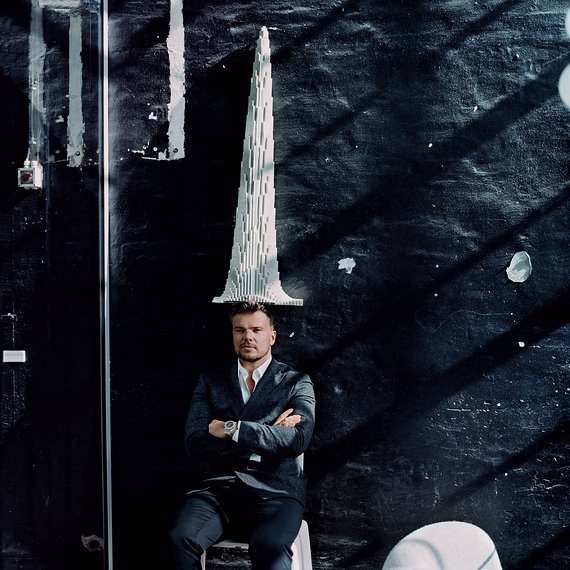
Bjarke Ingels has a habit of recounting the final moments of his architectural forebears, for anyone who can stomach them: Antoni Gaudí struck by a trolley on his way to church in Barcelona, Le Corbusier drowned in the Mediterranean. Of particular interest to the Danish-born architect, whose unwavering grin has a way of putting a bow on the macabre, are those ends met in his adopted hometown of New York City: Louis Kahn, newly returned from India, suffering a heart attack in the men’s room at Penn Station; Stanford White shot by the jealous husband of his former lover on the roof of the second of four incarnations of Madison Square Garden, which he happened to design.
“The history of New York is so much about perpetual rebirth,” Ingels explains. We are sitting in a pair of neon wool chairs in the otherwise rather underadorned offices of the Bjarke Ingels Group—known far and wide as BIG—which in 2015 moved its American headquarters near Wall Street. (The firm employs some 400 people in New York and Copenhagen.) “It’s taken as long to not finish this office space as it took to build the Empire State Building,” he goes on, “which tells you what amazing progress we’ve made in construction in the last century.” All around us, young men with thick beards and young women in chunky glasses and T-shirts and flat black sneakers stare into giant screens and speak to one another in whispers, while out the windows, New York’s varied volumes make a glorious display: the high modernism of One Liberty Plaza, the Woolworth Building’s neo-Gothic turrets, the Statue of Liberty poking through the mist beyond them. “It’s easy to overinterpret and see life as your own personal movie with yourself as the star of it, but this is an amazing time,” Ingels says, his hair a mess of brown, electrified-looking Warhol shocks.
It’s amazing indeed that Ingels, who moved to New York in 2010, now has more control over the next iteration of the city’s skyline than any other human being. Via 57 West, a 44-story, 709-unit apartment building whose prismatic glass-and-steel form opens onto the Hudson River like a geode, is Ingels’s first and only realized commission in the city, but there’s a long line to follow. An office building tentatively called the Spiral, composed of a series of ascending miniparks that form an extension of the High Line, is set to begin construction later this year if they find an anchor tenant, along with a hotel in the Meatpacking District and a housing complex in East Harlem. Ingels’s two largest-looming New York projects are connected to local tragedies, September 11 and Hurricane Sandy. BIG has designed 2 World Trade Center (though its anchor tenant, 21st Century Fox and News Corp., pulled out, which means that the project awaits a new benefactor), as well as the ten-mile-long downtown flood-protection infrastructure known as the BIG U. What makes his productivity all the more remarkable is that Ingels is 42, a mere toddler in architecture’s traditional creeping life cycle. (Consider that Frank Gehry was 78 when his first New York building was completed.)
“In a sense, being against something is almost being a follower in reverse,” says Ingels, who in 2009 published a manifesto of sorts, in comic-book form, buoyantly titled Yes Is More. “It’s the safest choice. Being affirmative is incredibly difficult, and you’ll get accused of all kinds of things. You always hear architects complaining about how their brilliant idea was watered down through compromise. My approach to architecture is really to try, in a Zen-like way, or like in aikido, to turn the force of your enemy into your own strength. By listening and observing and trying to accommodate the conditions we find, we arrive at something much more interesting.”
Many architects struggle to resolve the tension between the essence of their idea and a host of swirling contingencies—how a building will be used, what the budget will allow, what the neighbors think. But for Ingels, there is no essence. His architecture cannot be separated from those contingencies, and that’s the point. He has indeed been accused of all kinds of things—of shameless self-promotion (through social media, mainly), of saying yes to every commission that comes his way, of hewing to a limited formal vocabulary. But if Ingels is guilty of anything, it’s the indomitable will to get things made—which, because he has succeeded, has drawn the widespread envy of his peers. Architects routinely suffer from a Catch-22: You can’t build the thing until you’ve proved that you can build it. Ingels has circumnavigated this through a mix of charisma and canniness. In Copenhagen, his first commissions were apartment buildings, paid for by a developer, at a time when serious architects had lost interest in public housing in favor of museums and libraries.
“That was quite radical,” says Amale Andraos, dean of the Columbia School of Architecture and a colleague of Ingels’s from their days at OMA, Rem Koolhaas’s Rotterdam-based firm. Andraos remembers Ingels arriving at work on Rollerblades, his perpetual smile surprising given the intense pressure of the office. “He is interested in getting things made,” says Andraos, “promoting himself like a start-up, not waiting for someone to anoint him as the heir. That’s not how architecture’s patriarchal system has traditionally functioned. He burned down the house, and that’s a good thing. It helps that he’s talented, though there’s a lot of talent out there.”
I’ve never seen a building of his where I didn’t want to stay awhile,” says Nikolaj Coster-Waldau. “They’re kind to human beings
Ingels grew up in a modest single-story house in the suburbs outside Copenhagen, where his kindergarten teacher observed a precocious talent for perspective drawing, and his bedroom was given over to a constantly evolving Lego city. He enrolled in art school at Copenhagen’s Royal Academy of Arts with the dream of becoming a graphic novelist. “I remember being worried that I didn’t have enough anger,” he recalls. “The cliché of the avant-garde, the angry young man—that wasn’t me. I discovered the novelist Douglas Coupland, who writes about being middle-middle-middle-middle-class. It was somehow a relief to know that there was hope for the well-adjusted.” In art school Ingels fell in love with the work of Koolhaas and landed an internship at OMA. After he graduated, Koolhaas hired him to work on Seattle’s now iconic Central Library. Ingels left OMA in 2001 with a colleague to start a firm called PLOT; it dissolved four years later, and Ingels, just 31, founded BIG, whose name only he could (more or less) get away with. As the widely trafficked story goes, Ingels, a lover of puns, enjoys the fact that his firm’s Web address is big.dk.
In Denmark, Ingels made his name with a series of clever category-defying projects: a subterranean maritime museum in the shape of a boat; a garbage-fueled power plant with a vast slanted roof that will double as a ski slope and a chimney that will belch giant rings of steam when it is completed in 2018. His first affordable housing developments were adamantly utopian: One, in the shape of a figure eight, had a bike path that looped up and over ten stories of apartments. “A typical residential project follows a formula,” says Ingels. “Instead, I like to use the idea of an architectural game of Twister. You start in a traditional pose, and then as you pile on demands, suddenly you find yourself in a back bend with your face rubbing up against the private parts of your family members, and it becomes enjoyable and fun. That’s essentially what we’re trying to do.”
Advertisements Share this:




